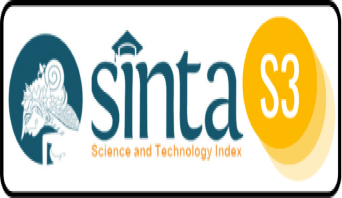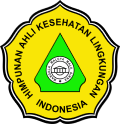ANALISIS FAKTOR CEMARAN SUMUR TERHADAP KEJADIAN HEPATITIS A DI KECAMATAN NGADIROJO KABUPATEN PACITAN
DOI:
https://doi.org/10.26630/rj.v14i1.2146Keywords:
Hepatitis A, dug-well construction, Escherichia coliAbstract
Hepatitis A is a fecal oral disease which is still a public health problem in Indonesia. The Pacitan Regency Government has determined an extraordinary event (KLB) of Hepatitis A since June 25th, 2019, there were 1,310 confirmed cases. This research aims to determine the relation between well contamination and the incidence of Hepatitis A.
This study used a case control design by means of observation and measurement of 36 dug wells randomly selected from 18 cases and 18 controls based on inclusion criteria. The water microbiology examination was carried out at the Surabaya Health Polytechnic Laboratory with the Most Probable Number (MPN) method, and the data analysis technique used was the serial point coefficient correlation.
The results suggested that all observed well water was contaminated by E. coli bacteria, and more than half of them did not meet the construction requirements, namely from the aspect of distance from pollutant sources, walls, lips and well floors. The analysis results suggested a relation between Escherichia coli contamination and well construction (p-value = 0.036). However, it did not show a significant relation with the incidence of Hepatitis A (p-Value = 0.514).
Improved well construction, increased knowledge, and hygiene behavior are efforts of which must be made in managing Hepatitis A.Â
References
Adam, M., Sumampouw, O. J., & Pinontoan, O. R. (2019). Kandungan Coliform dan Escherichia Coli Pada Sumber Air Bersih Di Desa Kumelembuai dan Kumelembuai Dua Kabupaten Minahasa Selatan. Juornal PHWB, 1(1), 36–44.
Afifah, F. (2019). Uji Bakteriologis Coliform Dan Escherichia Coli Pada Air Tanah Bebas. https://doi.org/10.31227/osf.io/fp9kr
Al Khakim, A. R. (2017). Dinamika Bakteri Coliform Disebabkan Oleh Tekanan, Kekeruhan dan Sisa Chlor di Kota Surabaya (FKM Universitas Airlangga). Retrieved from http://repository.its.ac.id/47732/
Apriliana, C., . D., & Sunarko, B. (2017). Pengaruh Konstruksi Sumur Gali Terhadap Kualitas Bakteriologis Air Bersih di Puskesmas Tekung Kabupaten Lumajang Tahun 2017. GEMA LINGKUNGAN KESEHATAN, 15(3). https://doi.org/10.36568/kesling.v15i3.695
Cahyono, S. B. (2009). Hepatitis A (Cegah penularannya). Yogyakarta: Kanisius.
Hasnawi, H., Kesehatan, J., Kesehatan, I.-I., Keolahragaan, D., Heriyani, A., Pengaruh, H. 2012, … Masyarakat, K. (2012). Pengaruh Konstruksi Sumur Terhadap Kandungan Bakteri Eschercia Coli Pada Air Sumur Gali di Desa Dopalak Kecamatan Paleleh Kabupaten Buol. In Public Health Journal (Vol. 1). State University of Gorontalo.
Ihsan, M. F., Sudarno, S., & Oktiawan, W. (2017). Kajian Kualitas Air Sumur Gali untuk Wilayah Pedalangan yang Mempunyai IPAL Komunal. Retrieved August 20, 2020, from Jurnal Teknik Lingkungan
Irfandi, A., Ashar, T., & Chahaya, I. (2014). Analisis Kandungan Kadmium (Cd) Dan Timbal (Pb) Pada Air Sumur Gali Penduduk di Sekitar Industri Daur Ulang Aki Dan Gangguan Kesehatan Pada Masyarakat Desa Bandar Khalipah Kabupaten Deli Serdang Tahun 2013. In Lingkungan dan Keselamatan Kerja (Vol. 3). University of North Sumatra.
Khomariyatika, T., & Pawenang, T. E. (2011). Kualitas Bakteriologis Air Sumur Gali. Kesmas, Jurnal Kesehatan Masyarakat, 7(1), 63–72. https://doi.org/10.15294/kemas.v7i1.1794
Muchlis, M., Thamrin, T., & Siregar, S. H. (2017). Analisis Faktor yang Mempengaruhi Jumlah Bakteri Escherichia coli pada Sumur Gali Penderita Diare di Kelurahan Sidomulyo Barat Kota Pekanbaru. Dinamika Lingkungan Indonesia, 4(1), 18. https://doi.org/10.31258/dli.4.1.p.18-28
Peraturan Menteri Kesehatan Republik Indonesia Nomor 32 tahun 2017. Standar Baku Mutu Kesehatan Lingkungan dan Persyaratan Kesehatan Air Untuk Keperluan Higiene Sanitasi, Kolam Renang, Solus Per Aqua, dan Pemandian Umum. , Peraturan Menteri kesehatan Republik Indonesia § (2017).
Pratiwi, E., Soekarso, T., Adam, K., & Setiawaty, V. (2017). Identifikasi Virus Hepatitis A pada Sindrom Penyakit Kuning Akut di Beberapa Provinsi di Indonesia Tahun 2013. Global Medical & Health Communication (GMHC), 5(3), 199. https://doi.org/10.29313/gmhc.v5i3.2386
Putri, E. S. (2017). Analisis Hubungan Pengetahuan, Sikap dan Kontruksi Sumur Gali Terhadap Kualitas Sumur Gali. Prosiding Seminar Nasional USM, 1(1), 481–486.
Rahadi, R. (2019). Hubungan Antara Faktor Lingkungan Dan Perilaku Dengan Kejadian Hepatitis A Pada Masyarat Bantaran Sungai Bengawan Solo Kota Surakarta. Retrieved from http://repository.setiabudi.ac.id/3366/1/INTISARI DAN ABSTRACT JURNAL RYAN.pdf
Ropiah, R., Hernawan, A. D., & Selviana, N. 1122028801. (2016). Faktor Lingkungan Dan Perilaku Yang Berhubungan Dengan Kejadian Hepatitis A Di Kecamatan Sintang Kabupaten Sintang (Universitas Muhamadyah Pontianak).
Sangadjisowohy, D. (2019). Uji Kandungan Bakteriologi Pada Air Sumur Gali Ditinjau Dari Konstruksi Sumur di Kelurahan Sangaji Kecamatan Ternate Utara. PROMOTIF: Jurnal Kesehatan Masyarakat, 9(1), 20–27. https://doi.org/http://dx.doi.org/10.31934/promotif.v9i1.577
Sapulete, M. R. (2013). Hubungan Antara Jarak Septic Tank Ke Sumur Gali dan Kandungan Escherichia Coli Dalam Air Sumur Gali di Kelurahan Tuminting Kecamatan Tuminting Kota Manado. JURNAL BIOMEDIK (JBM), 2(3). https://doi.org/10.35790/jbm.2.3.2010.1197
Sharon, T. L., Woodford, J. B., & Oksfriani, S. J. (2018). Hubungan Antara Faktor Konstruksi Dan Jarak Sumur Gali Terhadap Sumber Pencemar Dengan Total Coliform Air Sumur Gali di Kelurahan Motto Kecamatan Lembeh Utara. In Jurnal KESMAS (Vol. 7). Retrieved from https://ejournal.unsrat.ac.id/index.php/kesmas/article/view/23160
Sumarni, I., & Susanna, D. (2014). Kondisi Kesehatan Lingkungan Pesantren dan Perilaku Hidup Bersih dan Sehat Siswa dengan Kejadian Hepatitis. Kesmas: National Public Health Journal, 9(2), 179. https://doi.org/10.21109/kesmas.v9i2.515
Suni, N. S. P. (2019). Tantangan dalam penanggulangan kejadian luar biasa (klb) penyakit hepatitis a di pacitan. Pusat Penelitian Badan Keahlian DPR RI, 11(14), 13–18.
Syahrul, F. B. H., Mubawadi, F., Mirasa, T., & Agung, Y. (2018). Analisa Kejadian Luar Biasa Hepatitis A Di SMA X Kabupaten Lamongan Tahun 2018. Jurnal Berkala Epidemiologi, 6(2), 112–121.
Yushananta, P., & Ahyanti, M. (2017). Risiko Fotoreaktivasi terhadap Kualitas Mikrobiologi Air Minum Isi Ulang. Jurnal Kesehatan, 8(2), 212. https://doi.org/10.26630/jk.v8i2.482
Yushananta, P., Ahyanti, M., & Hasan, A. (2018). Sanitasi Total Berbasis Masyarakat di Desa Muara Putih Kecamatan Natar Kabupaten Pesawaran. Sakai Sambayan Jurnal Pengabdian Kepada Masyarakat, 2(2), 76. https://doi.org/10.23960/jss.v2i2.79
Yushananta, P., & Usman, S. (2018). The Incidence of Diarrhea in Babies Affected through the Cleanliness of Eating Utensils and Hands. Journal of Medical Science And Clinical Research, 6(9). https://doi.org/10.18535/jmscr/v6i9.137
Yustiani, Y. M., Hasbiah, A. W., & Fuad, R. (2019). Pengaruh Kondisi Fisik Dan Jarak Sumur Gali Dengan Peternakan Sapi Terhadap Kandungan Bakteri Coliform Air Sumur Gali di Desa Sukajaya Kecamatan Lembang Kabupaten Bandung Barat. Journal of Community Based Environmental Engineering and Management, 1(1), 19. https://doi.org/10.23969/jcbeem.v1i1.1367
Downloads
Published
How to Cite
Issue
Section
License
Copyright (c) 2020 Ruwa Jurai: Jurnal Kesehatan Lingkungan

This work is licensed under a Creative Commons Attribution-NonCommercial 4.0 International License.

Ruwa Jurai: Jurnal Kesehatan Lingkungan is licensed under a Creative Commons Attribution-NonCommercial 4.0 International License.
Authors who publish with this journal agree to the following terms:
- Authors retain copyright and grant the journal right of first publication with the work simultaneously licensed under a Creative Commons Attribution-Non Commercial License that allows others to share the work with an acknowledgment of the work's authorship and initial publication in this journal.
- Authors are able to enter into separate, additional contractual arrangements for the non-exclusive distribution of the journal's published version of the work (e.g., post it to an institutional repository or publish it in a book), with an acknowledgment of its initial publication in this journal.
- Authors are permitted and encouraged to post their work online (e.g., in institutional repositories or on their website) prior to and during the submission process, as it can lead to productive exchanges, as well as earlier and greater citation of published work.









